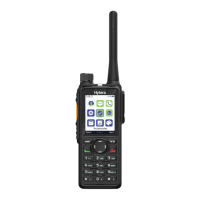● Institute of Electrical and Electronic Engineers (IEEE) C95.1-1999;
● International Commission on Non-Ionizing Radiation Protection (ICNIRP) 1998.
FCC Regulations
Federal Communication Commission (FCC) requires that all radio communication products should meet the
requirements set forth in the above standards before they can be marketed in the U.S, and the manufacturer shall
post a RF label on the product to inform users of operational instructions, so as to enhance their occupational
health against exposure to RF energy.
Operational Instructions and Training Guidelines
To ensure optimal performance and compliance with the occupational/controlled environment RF energy
exposure limits in the above standards and guidelines, users should transmit not more than 50% of the time and
always adhere to the following procedures:
● RF energy will be generated only when the radio is transmitting.
● The radio must be 2.5 centimeters away from human body when transmitting.
Hazardous Locations Certification Information
Compliance Standards
UL 913, 5th Ed. February 24, 1997
CAN/CSA C22.2 No. 157-92 (R2016)
ANSI/TIA-4950-A, Rev. May 13, 2014
Equipment marking
I.S Class I, II, III, Division 1, Groups C, D, E, F, G, T4
NI Class I, Division 2, Groups A, B, C, D, T4
–20°C to +60°C
Certificate Number
SGSNA/20/SUW/00085X
No Misoperations
Stop operating this product and leave the explosive atmosphere immediately when the safety or integrity of the
product is endangered, and deliver it to your local dealer for examination.
These items may endanger the product's safety or integrity:
● The radio is stored improperly;
● The radio is faulty;
● The radio works with overload;

